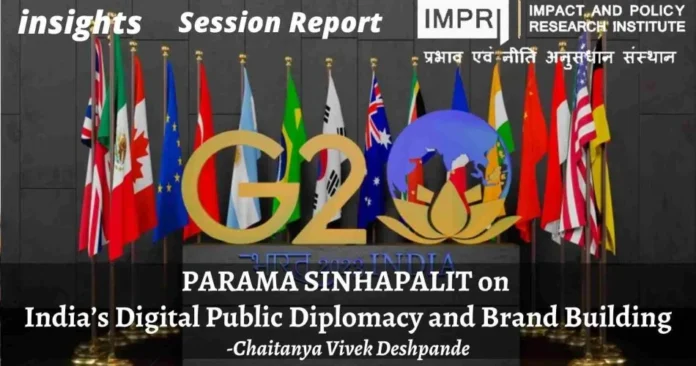A three-day online certificate training course on India’s G20 Presidency and Contours of Indian Foreign Policy was organized by #IMPRI Centre for International Relation and Strategic Studies (CIRSS), IMPRI Impact and Policy Research Institute, New Delhi from 14th to 16th March 2023. Inaugurating the session Aashwash Mahanta, a researcher at IMPRI, welcomed the speakers and participants to the program with an introduction to the eminent panelists. Dr Simi Mehta, CEO and Editorial Director, IMPRI, commenced the program by stating that the country is passing through tough times. Dr Mehta set the stage for the sessions to unfold.
An inaugural session of the course on Day 1 was related to India’s Digital Public Diplomacy and Brand Building. An insightful session on this topic was delivered by Dr Parama Sinhapalit, Adjunct Senior Fellow, at Rajaratnam School of International Studies (RSIS), Nanyang Technological University (NTU), Singapore.
The chief focus of the session was on India’s diplomacy through social media and its brand building. Social media has forced public diplomacy to become more public-oriented, emphasizing how India’s public diplomacy is focusing on brand-building activities using the G20 summit as a brand.
Public in Diplomacy
Dr. Palit argued that conventional public diplomacy essentially included influencing the foreign public now the New Public Diplomacy included the aspect of inclusion of the domestic public as well. The Indian government has initiated many websites for its ministries to reach out to domestic as well as foreign public audiences with its development agenda for New India. These efforts Dr. Palit points out are in the direction of brand building at the international level based on marketing and public relations principles.
Branding helps to connect with a particular policy emotionally. This happens especially in the case of diaspora and helps the state to build a bond with it. Dr Palit points out that it’s also almost impossible to attract investments without doing branding.
In this context, she looks at how India has been building its brand. It’s doing so by communicating its strengths primarily through social and digital media. These strengths include economic strength and prowess. Apart from global giants like Apple investing in India, initiatives like Make in India are used to make the Brand India strong. Also, the Ministry of External Affairs launched dedicated Twitter handles for its various programmes.
Operation Ganga where the stranded Indian students in Ukraine were evacuated was one such example. Operation Ganga established Twitter as a crisis-managing tool for India’s public diplomacy. The evacuation also included students from neighbouring countries. The praise for India established itself again as a ‘responsible power.’
Another example of public diplomacy by India through digital media is the Vaccines given to different nations during Covid Pandemic. Professor Sinhapalit quotes Foreign Policy Magazine which appreciated India’s crafting of response to Covid both at the domestic and international levels with a tech-savvy PM at the lead. This approach had many diplomatic advantages.
Along with the crisis and Covid, the cultural aspect of India’s rich heritage has been projected using digital public diplomacy. The declaration of 21st June as the International Day of Yoga by the UN is a very prominent example of this. Along with this, dances, and other cultural festivals being celebrated all over the world is an attempt by India to get placed on the global high pedestal of recognition and reputation.
Engaging with the diaspora to maintain and improve relations with a foreign country is also a part of public diplomacy. India is no exception in this regard. Prof. Palma Palit observes that the election of Narendra Modi as Prime Minister of India in 2014 and 2019 was followed by skillful cultivation of social media as a tool to engage with the Indian diaspora. Communicating India’s powers, strength and influence to the diaspora is important for this government.
India’s efforts to protect its ‘brand’ at the International level are clearly visible through G20 meetings. PM Modi’s speech which is shown during the session of Dr Sinhapalit at the first Ministerial level conference of Finance Ministers is an example of how the economic strengths of India are communicated to the world as it is a brand. PM Modi vouched for the ‘inclusiveness’ of the most vulnerable section of society in the economic growth in the Post Pandemic era.
The speech also highlighted the progress made by India on the front of Digital Payment infrastructure which facilitates ‘contactless’ and seamless transactions. PM Modi said that India has created highly secure, highly trusted and highly efficient public digital infrastructure. From the Indian perspective, G 20 Summit is a vehicle to promote this progress and its core, the UPI payment system at the world level. The speech also conveys the ‘Ease of Doing Business’ in India and a technology-friendly attractive consumer base for the world market.
Another example of India’s public diplomacy is marketing Millets in the world. India is the top producer of millet. India is also trying to promote millet consumption in the diet of G20 guests. Apart from G 20, the Ministry of External Affairs is also promoting ‘South-South Food Cooperation’ through media like Facebook.
Conclusion
In conclusion of the session, Dr Sinhapalit analyses India’s standing on the world stage using its public diplomacy. India is seen as a ‘potential power’ in the PEW survey while a ‘rising’ power in Europe and America according to What the world thinks to Report 2019.
However, apart from these brand-strengthening facts, the weaknesses involve the widespread inequality and poverty in the country and rising intolerance. These weaknesses will reduce the credibility of the Indian brand. G20 provides an opportunity to further the strengths of the Indian brand by showcasing its rich heritage, and business potential and meanwhile work on its weaknesses.
Session Report
Chaitanya Vivek Deshpande
https://bityl.co/JoyL








